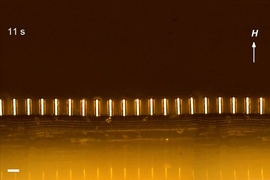MIT engineers have fabricated a new elastic material coated with microscopic, hairlike structures that tilt in response to a magnetic field. Depending on the field’s orientation, the microhairs can tilt to form a path through which fluid can flow; the material can even direct water upward, against gravity.
Each microhair, made of nickel, is about 70 microns high and 25 microns wide — about one-fourth the diameter of a human hair. The researchers fabricated an array of the microhairs onto an elastic, transparent layer of silicone.
In experiments, the magnetically activated material directed not just the flow of fluid, but also light — much as window blinds tilt to filter the sun. Researchers say the work could lead to waterproofing and anti-glare applications, such as “smart windows” for buildings and cars.
“You could coat this on your car windshield to manipulate rain or sunlight,” says Yangying Zhu, a graduate student in MIT’s Department of Mechanical Engineering. “So you could filter how much solar radiation you want coming in, and also shed raindrops. This is an opportunity for the future.”
In the near term, the material could also be embedded in lab-on-a-chip devices to magnetically direct the flow of cells and other biological material through a diagnostic chip’s microchannels.
Zhu reports the details of the material this month in the journal Advanced Materials. The paper’s co-authors are Evelyn Wang, an associate professor of mechanical engineering, former graduate student Rong Xiao, and postdoc Dion Antao.
Nature’s dynamics
The inspiration for the microhair array comes partly from nature, Zhu says. For example, human nasal passages are lined with cilia — small hairs that sway back and forth to remove dust and other foreign particles. Zhu sought to engineer a dynamic, responsive material that mimics the motion of cilia.
“We see these dynamic structures a lot in nature,” Zhu says. “So we thought, ‘What if we could engineer microstructures, and make them dynamic?’ This would expand the functionality of surfaces.”
Zhu chose to work with materials that move in response to a magnetic field. Others have designed such magnetically actuated materials by infusing polymers with magnetic particles. However, Wang says it’s difficult to control the distribution — and therefore the movement — of particles through a polymer.
Instead, she and Zhu chose to manufacture an array of microscopic pillars that uniformly tilt in response to a magnetic field. To do so, they first created molds, which they electroplated with nickel. They then stripped the molds away, and bonded the nickel pillars to a soft, transparent layer of silicone. The researchers exposed the material to an external magnetic field, placing it between two large magnets, and found they were able to control the angle and direction of the pillars, which tilted toward the angle of the magnetic field.
“We can apply the field in any direction, and the pillars will follow the field, in real time,” Zhu says.
Tilting toward a field
In experiments, the team piped a water solution through a syringe and onto the microhair array. Under a magnetic field, the liquid only flowed in the direction in which the pillars tilted, while being highly “pinned,” or fixed, in all other directions — an effect that was even seen when the researchers stood the array against a wall: Through a combination of surface tension and tilting pillars, water climbed up the array, following the direction of the pillars.
Since the material’s underlying silicone layer is transparent, the group also explored the array’s effect on light. Zhu shone a laser through the material while tilting the pillars at various angles, and found she could control how much light passed through, based on the angle at which the pillars bent.
In principle, she says, more complex magnetic fields could be designed to create intricate tilting patterns throughout an array. Such patterns may be useful in directing cells through a microchip’s channels, or wicking moisture from a windshield. Since the material is flexible, Wang says that it may even be woven into fabric to create rain-resistant clothing.
“A nice thing about this substrate is that you can attach it to something with interesting contours,” Wang says. “Or, depending on how you design the magnetic field, you could get the pillars to close in like a flower. You could do a lot of things with the same platform.”
This research was supported by funding from the Air Force Office of Scientific Research.










